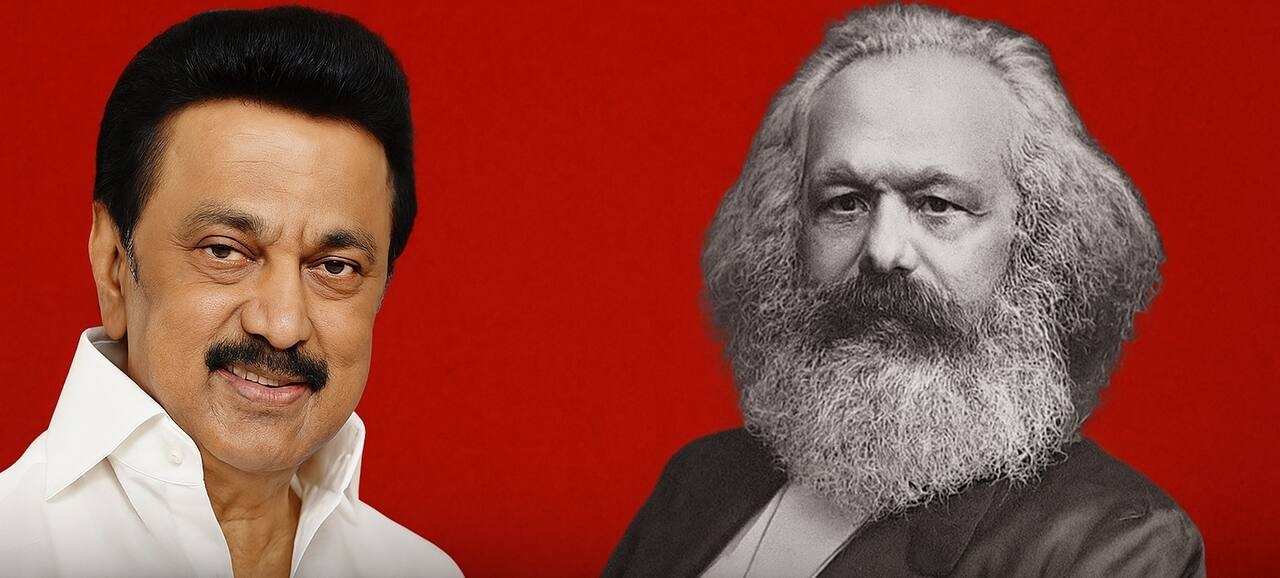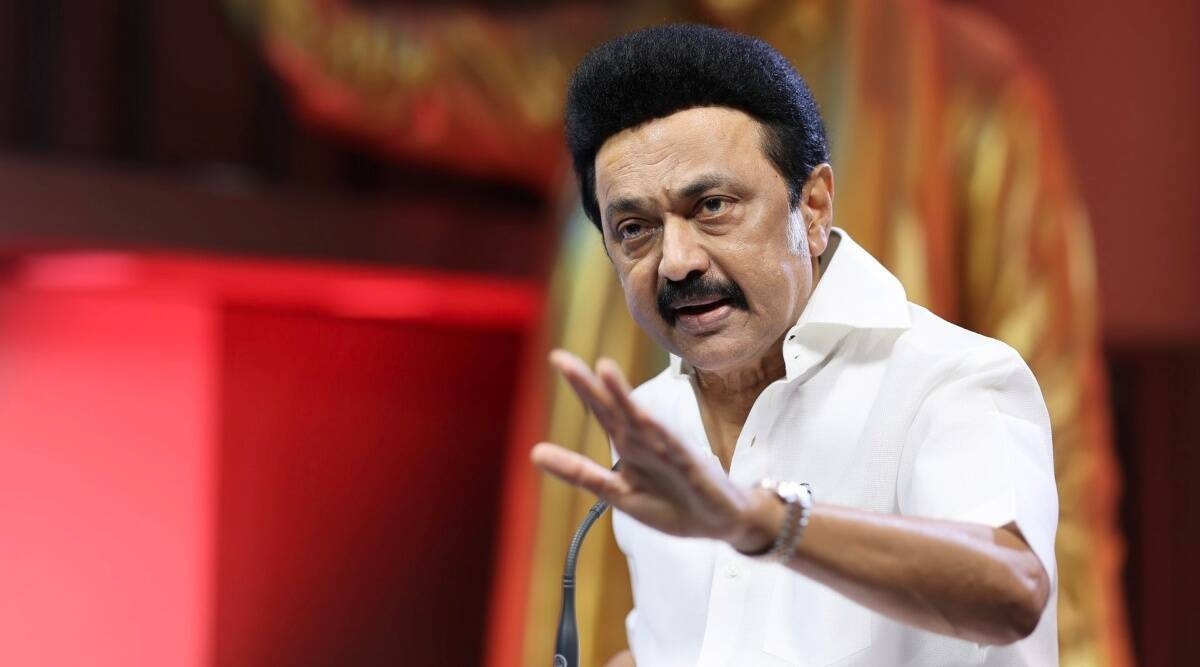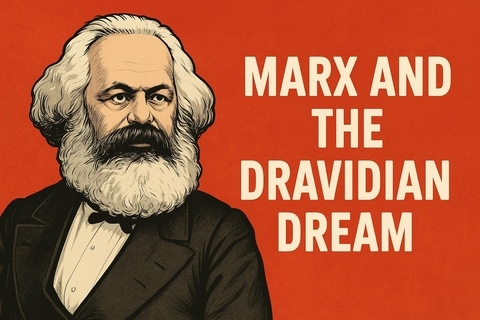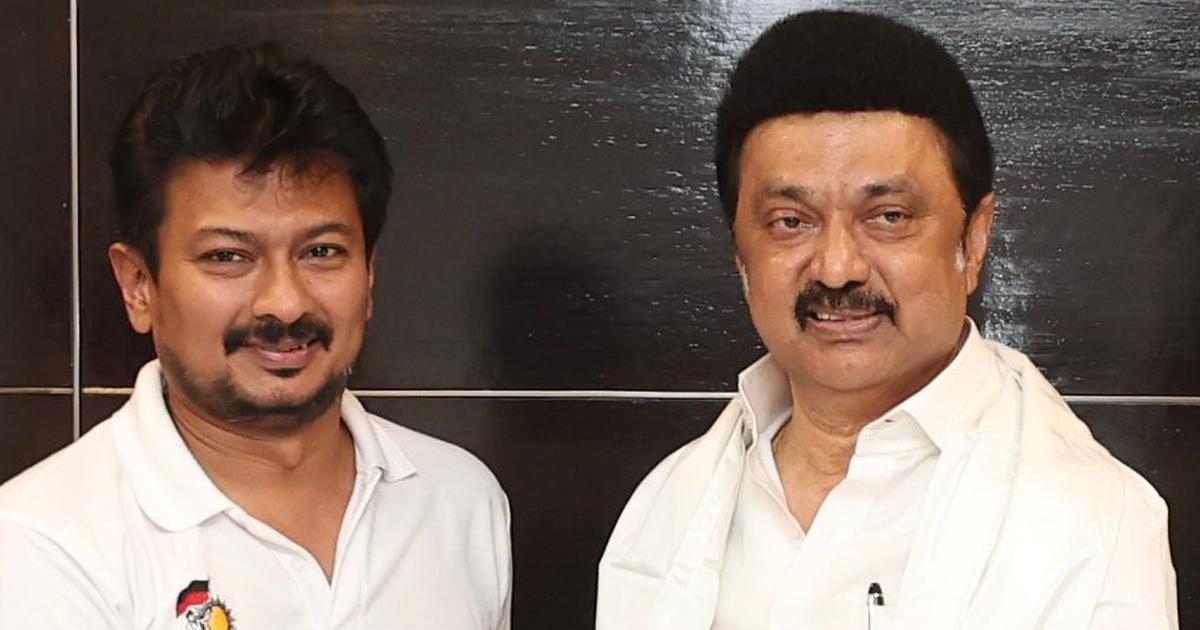Marx and the Dravidian Dream: DMK’s Newest Cultural Icon

It began, like all grand moments in modern Tamil Nadu politics, not with a spiritual awakening or a deep rediscovery of Tamil literature, but with a Rule 110 announcement in the Tamil Nadu Assembly. Chief Minister M.K. Stalin, standing tall as the custodian of the so-called Dravidian model, looked across the assembly floor and proclaimed:
“The Dravidian model government wishes to honour and pay tribute to the great global leader Karl Marx — a visionary thinker and revolutionary who formulated the philosophy of communism and gave the call: Workers of the world, unite!”

Thunderous applause followed. Not for Tamil poets, not for the sages who gave this land its civilisational identity, but for a bearded German philosopher who had nothing to do with Tamil Nadu — culturally, spiritually, or geographically.
A man who rejected religion, despised tradition, and never once set foot on Indian soil, let alone Tamil land, had now become a symbol of Tamil pride. One might have asked, “What connection does Karl Marx have with the Tamil language, with Tamil literature, with Tiruvalluvar, or with the legacy of Madurai’s temples?” But to ask such questions is to invite trouble in an environment where political symbolism has replaced substance.
Tamil First — As Long As It’s Not Hindu
For years, the ruling regime in Tamil Nadu has shouted from every rooftop: “Tamil first, Tamil forever.” From the Assembly to the streets, the slogans resonate: Tamil language, Tamil identity, Tamil pride. And yet, this pride seems strangely selective.
When it comes to opposing Hindi, there is no compromise. It is labelled an imposition, a symbol of northern tyranny, a linguistic invasion. But when Karl Marx’s German prose is quoted in political speeches, there is no protest, no questioning of “cultural imposition.” Apparently, German ideology is more Tamil than Sanskrit shlokas.
Hindu temples are seen as remnants of oppressive systems. Hindu gods are dismissed as outdated myths. The Sanatana Dharma, the very soul of Indian civilisation, is branded as something to be “eradicated” — words proudly declared by none other than the Chief Minister’s son, Udhayanidhi Stalin. But somehow, the writings of a 19th-century European atheist are celebrated as spiritual inspiration for modern Tamil society.
It is a curious case of ideological tourism: reject your own gods, but adopt foreign ones with revolutionary credentials.
The Rise of Saint Karl of Marina
Karl Marx, in life, was a man of conviction. He detested religion, viewed it as an opiate. He had no time for traditions or rituals. He believed in dismantling every form of cultural continuity. And yet, in death, he has been reborn in Chennai — not as a German philosopher, but as a new-age saint of the Dravidian movement.
Posters are already being designed. Red flags are fluttering. Leftist intellectuals, who were beginning to feel lonely in a post-communist world, have now found reason to cheer. The great Marx shall now stand tall — not in Berlin or London, but in the heart of Tamil Nadu, next to temples they seek to destroy.

Will the statue have traditional garlands? Probably not — that would be too religious. Will a priest perform a ritual? Absolutely not — that would defile the atheist purity of Marxism. Instead, expect a secular inauguration with speeches, slogans, and perhaps a performance by artists who see art as activism and culture as conflict.
The Selective Amnesia of the Dravidian Elite
This is not the first time Tamil Nadu has witnessed this sort of ideological contradiction. The Dravidian movement, which began as a response to so-called Brahminical dominance, has over time evolved into an attack on the entirety of Hindu civilisation. The line between social reform and cultural erasure has become increasingly blurred.
Meanwhile, foreign ideologies are embraced without critique. Marxism, an ideology that collapsed economies and destroyed cultures across continents, is presented as the solution to India’s complex social fabric. Never mind that it failed in Russia. Or in China, where Marxist ideals now serve only as decorative slogans while capitalism runs the show. In Tamil Nadu, it remains a holy scripture — not to be questioned, only to be followed.
The Holy Family of Anti-Sanatana
The Stalin family is not known for mincing words. M.K. Stalin, named after the Soviet dictator with great affection by his father, has followed in the footsteps of Periyar and Karunanidhi in maintaining a strict distance from anything remotely “Hindu.” Not just Brahminical, not just orthodox — anything Hindu.
When his son Udhayanidhi Stalin declared Sanatana Dharma must be eradicated, it was not a gaffe. It was an ideological affirmation. When temples are reduced to bureaucratic departments and their funds diverted for "secular" causes, it is not an accident. It is a systematic dismantling of heritage under the banner of rationalism.

And yet, the same rationalists who cannot tolerate a priest lighting a lamp will worship the statue of a white German atheist as if he were born on the banks of the Kaveri. This isn’t rationalism. It’s a new kind of blind faith — one where ideology replaces divinity, and slogans replace scriptures.
Cultural Erasure Dressed as Progress
There is something deeply tragic about a civilisation that forgets its roots. Tamil Nadu is one of the oldest cultural regions in the world. Its temples are marvels of architecture. Its saints, poets, and philosophers have contributed richly to India’s collective soul. And yet, today, their voices are being drowned out — not by invaders, but by those who claim to represent them.
In the name of “social justice,” temples are under siege. In the name of “progress,” ancient traditions are mocked. In the name of “Dravidian identity,” the very soul of Tamil culture — which is intricately woven with Sanatana values — is being severed.
And into this vacuum walks Karl Marx, dragged across continents and centuries to be installed like a saviour in the land of Thiruvalluvar and Agastya. He did not ask for this. He probably would have rejected it. But ideology is a strange beast — it will use even the dead if it serves a narrative.
The Future of Statues, the Fate of Civilisation
As Tamil Nadu prepares to welcome yet another statue — this time not of a Tamil saint, not of a spiritual figure, not even of a poet who celebrated the soil — but of Karl Marx, one must ask a deeper question: what is the legacy we are building?
Are statues now just ideological statements, devoid of cultural context? Are we so insecure in our own roots that we must import thinkers to replace our own? Is this Dravidian pride, or a cleverly disguised rejection of everything truly Dravidian?
There are whispers now — of more statues. Perhaps next, it will be Lenin. Or Che Guevara. Maybe even Stalin — the Russian one. After all, the lines between names and ideologies have long since blurred.
In the end, the statues will stand. Silent. Stone. Symbolic. But they will not speak. It is the people who must speak. It is the youth of Tamil Nadu who must ask: Is this our identity, or someone else's ideology imposed upon us in a local accent?
In the Shadow of Marx, the Silence of Tamil Saints
The statue of Karl Marx will rise. Cameras will click. Slogans will be shouted. Speeches will be made. And somewhere in the background, unnoticed, an old temple will continue to crumble, unattended and unfunded. A Tamil poet’s statue will gather dust. A classical singer will be denied a platform for being “too traditional.” And a generation will grow up believing that their identity is best found in rebellion, not in roots.
But cultures do not survive on borrowed philosophies. They survive when they honour their own. In the race to appear modern, Tamil Nadu may be forgetting the ancient wisdom that made it glorious in the first place.
And as Karl Marx takes his place in Chennai’s skyline, one can only wonder: is he the symbol of a new awakening — or the tombstone of a civilisation’s slow suicide?